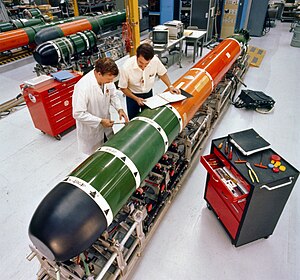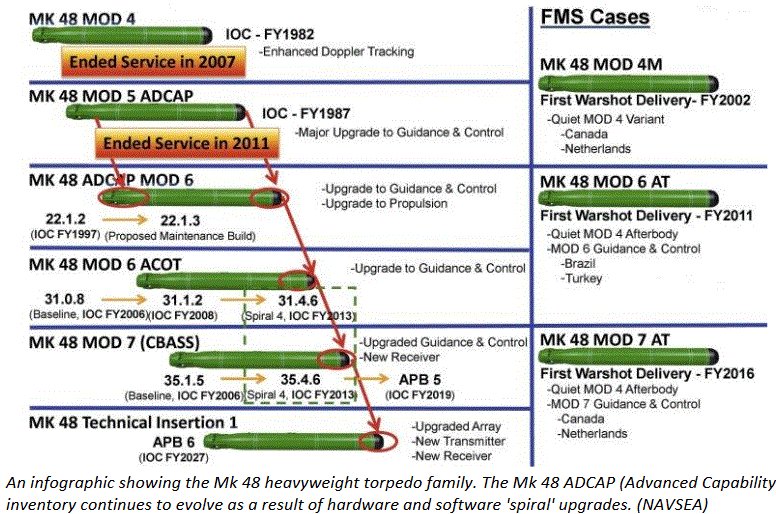Mark 48 torpedo
| Mark 48 torpedo | |
|---|---|
 Technicians perform maintenance on a Mark 48 torpedo in 1982. | |
| Type | Heavyweight torpedo |
| Place of origin | United States |
| Service history | |
| In service | 1972–present (Mod 1)[1]
1988–present (ADCAP) 2008–present Mod 7 Common Broadband Advanced Sonar System (CBASS) |
| Used by | Hughes Aircraft (ADCAP)
Westinghouse Naval Systems Cleveland Ohio |
| Unit cost | $894,000 (1978 USD) swash-plate piston engine; pump jet |
| Propellant | Otto fuel II |
| Maximum depth | 500 fathoms,[6] 800 m (2,600 ft) (estimated),[7] officially "greater than 1,200 ft"[8] |
| Maximum speed | 55 kn (63 mph; 102 km/h)[6] (estimated)[7] officially "greater than 28 kn (52 km/h; 32 mph)" |
Guidance system | Common Broadband Advanced Sonar System |
Launch platform | submarine |
The Mark 48 and its improved Advanced Capability (ADCAP) variant are American heavyweight submarine-launched torpedoes. They were designed to sink deep-diving nuclear-powered submarines and high-performance surface ships.
History
The Mark 48 was initially developed as REsearch TORpedo Concept II (RETORC II), one of several weapons recommended for implementation by
Deployment
The Mk-48 torpedo is designed to be launched from submarine torpedo tubes. The weapon is carried by all
Mk-48 and Mk-48 ADCAP torpedoes can be guided from a submarine by
Propulsion
The
Sensors and improvements
The torpedo's seeker has an active electronically steered "pinger" (2D phased array sonar) that helps avoid having to maneuver as it approaches the target. Unconfirmed reports[by whom?] indicate that the torpedo's sensors can monitor surrounding electrical and magnetic fields. This may refer to the electromagnetic coils on the warhead (at least from 1977 to 1981), used to sense the metallic mass of the ship's hull and detonate at the proper stand-off distance.
The torpedo has been the subject of continued improvement over its service lifetime. In the 1990s, a Mod 6 variant of the ADCAP provided much improved noise isolation for the engine, which makes this torpedo more difficult to detect for a potential target.
The Mk48 Mod 7 Common Broadband Advanced Sonar System (CBASS) torpedo is optimized for both the deep and littoral waters and has advanced counter-countermeasure capabilities. The MK48 ADCAP Mod 7 (CBASS) torpedo is the result of a Joint Development Program with the Royal Australian Navy and reached Initial Operational Capability in 2006.[8] The modular Mod 7 variant increases sonar bandwidth, enabling it to transmit and receive pings over a wider frequency band, taking advantage of broadband signal processing techniques to greatly improve search, acquisition, and attack effectiveness. This version is much more resistant to enemy countermeasures.[12]
On July 25, 2008 a MK 48 Mod 7 CBASS torpedo fired by an Australian
In 2015 the USN announced plans to restart production and seek a more modular design.
Starting in 2003, the US Navy began the Stealth Torpedo Enhancement Program which aims to upgrade the capability of the existing Mk 48 design by implementing alternative fuel sources including electric fuel cells, and a "swim out" capability, a capability that allows a torpedo to leave the tube under its own power without using a torpedo tube's noisier compressed air launch system. The program is ongoing, with many details yet classified.[17]

Operators

Current operators
 Royal Australian Navy
Royal Australian Navy Brazilian Navy
Brazilian Navy Royal Canadian Navy
Royal Canadian Navy Royal Netherlands Navy
Royal Netherlands Navy United States Navy
United States Navy Republic of China Navy[18]
Republic of China Navy[18]
See also
- American 21 inch torpedo
- Baek Sang Eo (White Shark) torpedo
- Black Shark torpedo
- DM2A4
- F21 Artemis
- Futlyar
- Spearfish torpedo
- Tigerfish torpedo
- Torped 62
- Type 65 torpedo
- Type 89 torpedo
- Varunastra (torpedo)
- Yu-6 torpedo
References
- ^ a b c Jolie, E.W. (15 September 1978). "A Brief History of US Navy Torpedo Development: Torpedo Mine Mk48". Retrieved 21 June 2013.
- ^ Polmar, Norman. "The Ships and Aircraft of the U.S. Fleet: Torpedoes". United States Naval Institute Proceedings, November 1978, p. 159.
- ^ a b "MK 48". Federation of American Scientists Military Analysis Network. www.fas.org. Retrieved 2011-04-06.
- ^ "Mark 48 CBASS". www.deagel.com.
- ^ "New Look at Air Force's Ship-Killing Smart Bomb in Action, Seeker Details Revealed". 22 September 2022.
- ^ ISBN 0-9610724-8-2. p. 190.
- ^ a b c d "Mk 48 ADCAP". Jane's Naval Forces News. www.janes.com. Archived from the original on April 1, 2001. Retrieved 2011-04-06.
{{cite web}}: CS1 maint: unfit URL (link) - ^ US Navy, 17 January 2009, Retrieved 10 March 2010.
- ISBN 1-55750-260-9.
- ^ Osborn, Kris (24 November 2017). "Navy Engineers New Lethal, Super High-Tech Mk 48 Torpedo". Scout.com. Retrieved 27 November 2017.[permanent dead link]
- ^ D'Costa, Ian. "This is what makes the Mark 48 one of the deadliest torpedoes ever built". We are the mighty. Mighty Networks. Retrieved 18 April 2018.
- ^ The U.S. Navy's New Lethal Torpedo Is Almost Ready for War - Nationalinterest.org, 31 May 2016
- ^ "Aussie sub sinks US Warship". The Sydney Morning Herald. 25 July 2008. Archived from the original on 26 July 2008.
An Australian submarine has fired a new heavy torpedo for the first time and sunk a US warship. But, rest easy, the dramatic event was part of an exercise and not a sudden deterioration in relations with the US. [...] The new heavyweight torpedo, jointly developed by Australia and the US, was fired yesterday during the Rim of the Pacific 2008 (RIMPAC 08) exercise. Multiple navies are taking part in the exercise off the coast of Hawaii, which featured the planned sinking of a retired US warship. The MK 48 Mod 7 Common Broadband Advanced Sonar System (CBASS) torpedo is considered the world's premier submarine-launched torpedo.
- ^ "BBC Video: Torpedo test sinks US ship". BBC. July 24, 2008. Retrieved 2011-04-06.
- ^ Eckstein, Megan (29 October 2015). "Navy Planning Torpedo Restart, Would Be Modular Design With Multiple Payloads". news.usni.org. USNI. Retrieved 29 October 2015.
- ^ Mizokami, Kyle (December 27, 2016). "The U.S. Navy is Getting a More Lethal Torpedo". Popular Mechanics. Archived from the original on December 28, 2016.
Defense contractor Lockheed Martin is upgrading existing Mark 48s to a new standard. A new, upgraded torpedo will run quieter, have an improved propulsion system, be more resistant to electronic countermeasures, and have an all-new guidance control system known as Common Broadband Advanced Sonar System, or CBASS. The new system should allow for locking onto enemy vessels at even longer ranges. In addition to upgrading older torpedoes, Lockheed will deliver 250 more brand new Mark 48s to the U.S. Navy.
- ISBN 978-0-309-06926-7.
- ^ "Armed with a heavyweight torpedo made to 'break ships in half,' Taiwan's first homemade submarine represents a new threat to China's navy". Business Insider. 23 Oct 2023.
External links
- Mk 48 at Raytheon Company
- US Navy Fact File Archived 2020-07-27 at the Wayback Machine
